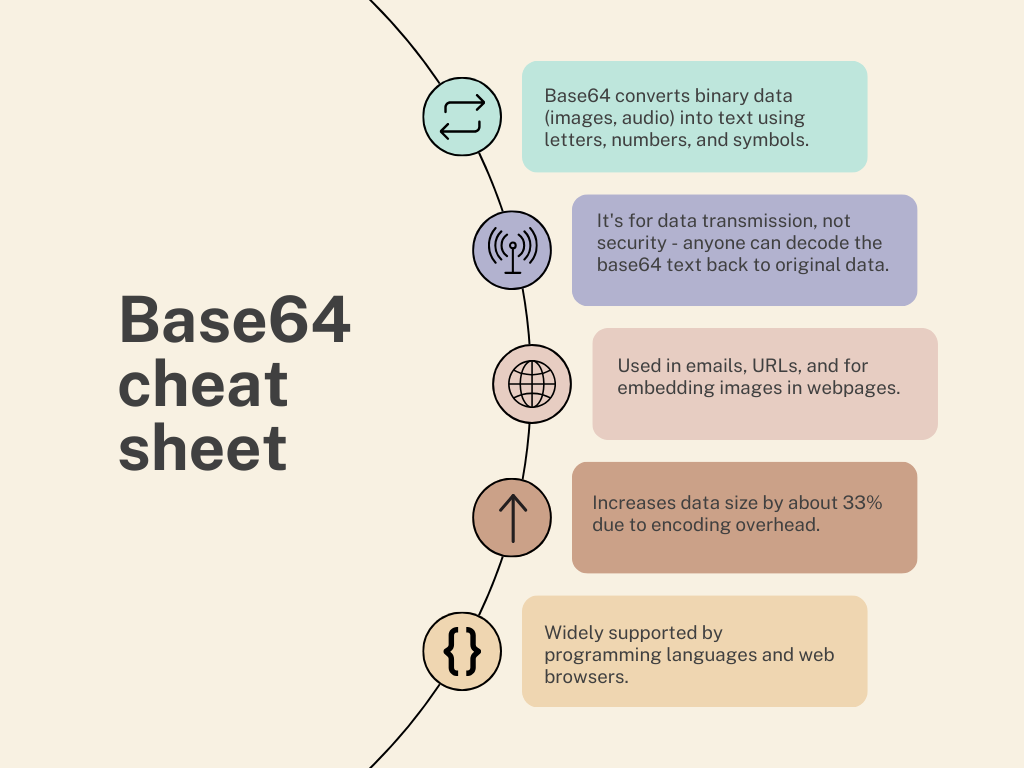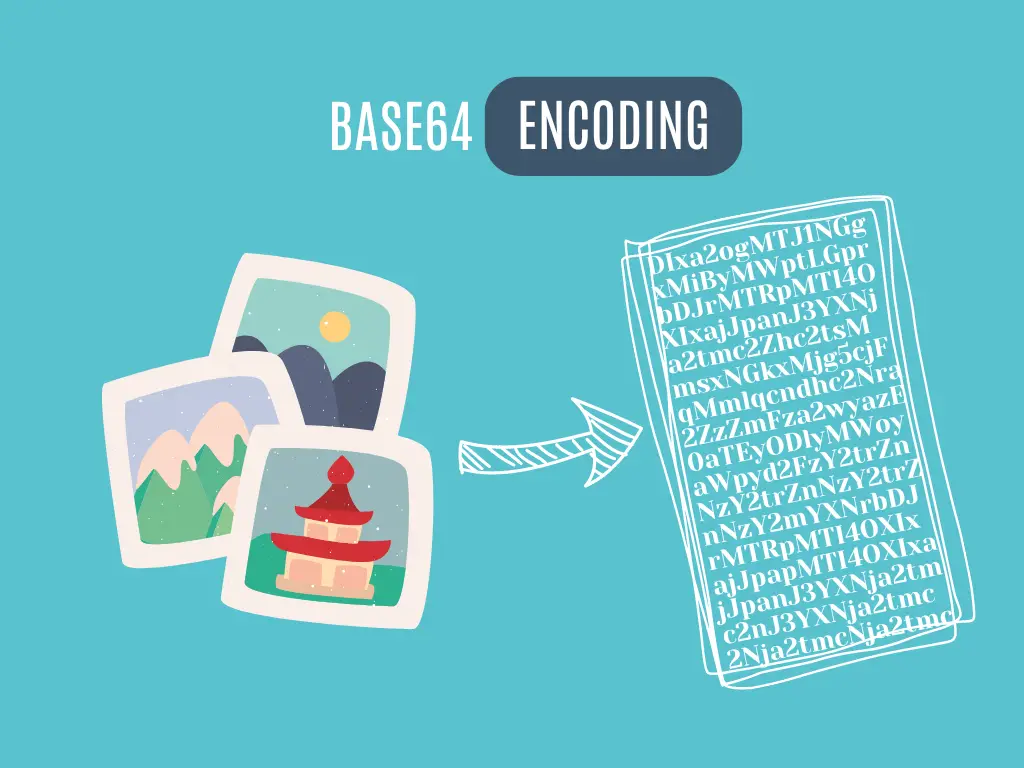Our HEIC to Base64 Encoder is the ultimate solution for converting HEIC images into Base64 format with ease. Whether you’re dealing with HEIC files from your Apple device or need to integrate this conversion into your workflow, our tool simplifies the process. Say goodbye to compatibility issues and hello to efficient HEIC-to-Base64 conversion.
HEIC to Base64 Converter
Upload an Image
Settings
What is Base64?
Base64 is a widely-used encoding scheme that transforms digital data into a format suitable for seamless transport and storage across various platforms and systems.
At its core, Base64 encoding converts binary data into a set of ASCII characters, allowing for efficient and reliable transmission and storage of information. By representing digital data using a set of printable characters, Base64 encoding ensures that data can be easily transferred and stored without corruption or loss, even in environments that support only text-based data.
This makes Base64 an essential tool for a wide range of applications, from email attachments and image encoding to secure data transfer and storage.

Here’s a quick Base64 breakdown:
- Binary to Text: This process converts data with jumbled 0s and 1s into letters, numbers, and symbols.
- Data Transmission: Makes it easier to send binary data through channels that only accept text.
- Not Encryption: The Base64 text is not secure because anyone may decode it back to the original data.
- Increased Size: The conversion process adds extra characters, making the encoded data about a third larger.
What is Base64 Encoding?
In general, encoding is the process of transforming data from one format to another. Base64 encoding is accomplished by expressing binary data with a set of 64 ASCII characters. This encoding is very useful when exchanging data across computers that do not natively accept binary data.
To illustrate with a simple example, Base64 encoding is a method of converting binary data (such as images, sounds or documents) into a 64-character text format.

How Does Base64 Encoding Work?
Base64 encoding is based on a straightforward principle: it separates binary data into 6-bit chunks and translates these chunks to ASCII letters. This results in a text-based representation that can be reliably sent across platforms.
What is HEIC?
HEIC (High-Efficiency Image File Format) is a file format extensively used on Apple devices for storing photos. It provides high-quality picture compression, making it a good option for reducing space without sacrificing image quality.
Some important information about the HEIC format:
- Smaller File Size: Stores images with similar quality to JPEG but at half the size, saving storage space on devices.
- Apple Favorite: The default image format on iPhones and iPads since iOS 11.
- Not Universally Supported: Some older devices and software may not recognize or open HEIC files.
- Conversion Possible: Can be converted to JPG for wider compatibility, but might cause slight quality loss.
- High Quality Option: A good choice for photographers and users who value image quality without sacrificing storage space (on compatible devices).
What is a HEIC to Base64 Converter?
A HEIC to Base64 Converter is a program that converts HEIC images to Base64-encoded files. Images can be represented as text strings in this format, making them easier to embed in web pages, emails, and other platforms that support text-based data.
How Do I Use the Online HEIC to Base64 Encoder?
- First, upload your HEIC image.
- No need to press a button, just wait until the encoding is complete. For large files, this may take longer.
- You can copy the result using the Copy button.
How does the HEIC to Base64 Converter work?
The HEIC to Base64 Converter uses the Base64 encoding algorithm to convert an HEIC image file into a string of characters. This encoded string represents the binary data of the HEIC image, allowing images to be stored and shared as text.
Why would I need to convert a HEIC image to Base64?
Converting an image to Base64 might be beneficial when you wish to incorporate HEIC pictures straight into HTML or CSS code without the need for separate image files. It may also be used to share photos in text-based settings like emails or databases.
Is it secure to use your HEIC to Base64 Converter?
Yes, because security is of the utmost priority to us, so the whole operation is client-side, which means that we don’t send any data you’ve converted to our server, the whole conversion takes place on your device, in your browser.
Base64 Characters
The Base64 character set consists of 64 characters, including letters, numbers, and special characters. In addition to the 64 characters, there is also a padding character, which is the equals sign “=”.
| Value | Character | Binary Value |
|---|---|---|
| 0 | A | 000000 |
| 1 | B | 000001 |
| 2 | C | 000010 |
| 3 | D | 000011 |
| 4 | E | 000100 |
| 5 | F | 000101 |
| 6 | G | 000110 |
| 7 | H | 000111 |
| 8 | I | 001000 |
| 9 | J | 001001 |
| 10 | K | 001010 |
| 11 | L | 001011 |
| 12 | M | 001100 |
| 13 | N | 001101 |
| 14 | O | 001110 |
| 15 | P | 001111 |
| 16 | Q | 010000 |
| 17 | R | 010001 |
| 18 | S | 010010 |
| 19 | T | 010011 |
| 20 | U | 010100 |
| 21 | V | 010101 |
| 22 | W | 010110 |
| 23 | X | 010111 |
| 24 | Y | 011000 |
| 25 | Z | 011001 |
| 26 | a | 011010 |
| 27 | b | 011011 |
| 28 | c | 011100 |
| 29 | d | 011101 |
| 30 | e | 011110 |
| 31 | f | 011111 |
| 32 | g | 100000 |
| 33 | h | 100001 |
| 34 | i | 100010 |
| 35 | j | 100011 |
| 36 | k | 100100 |
| 37 | l | 100101 |
| 38 | m | 100110 |
| 39 | n | 100111 |
| 40 | o | 101000 |
| 41 | p | 101001 |
| 42 | q | 101010 |
| 43 | r | 101011 |
| 44 | s | 101100 |
| 45 | t | 101101 |
| 46 | u | 101110 |
| 47 | v | 101111 |
| 48 | w | 110000 |
| 49 | x | 110001 |
| 50 | y | 110010 |
| 51 | z | 110011 |
| 52 | 0 | 110100 |
| 53 | 1 | 110101 |
| 54 | 2 | 110110 |
| 55 | 3 | 110111 |
| 56 | 4 | 111000 |
| 57 | 5 | 111001 |
| 58 | 6 | 111010 |
| 59 | 7 | 111011 |
| 60 | 8 | 111100 |
| 61 | 9 | 111101 |
| 62 | + | 111110 |
| 63 | / | 111111 |







